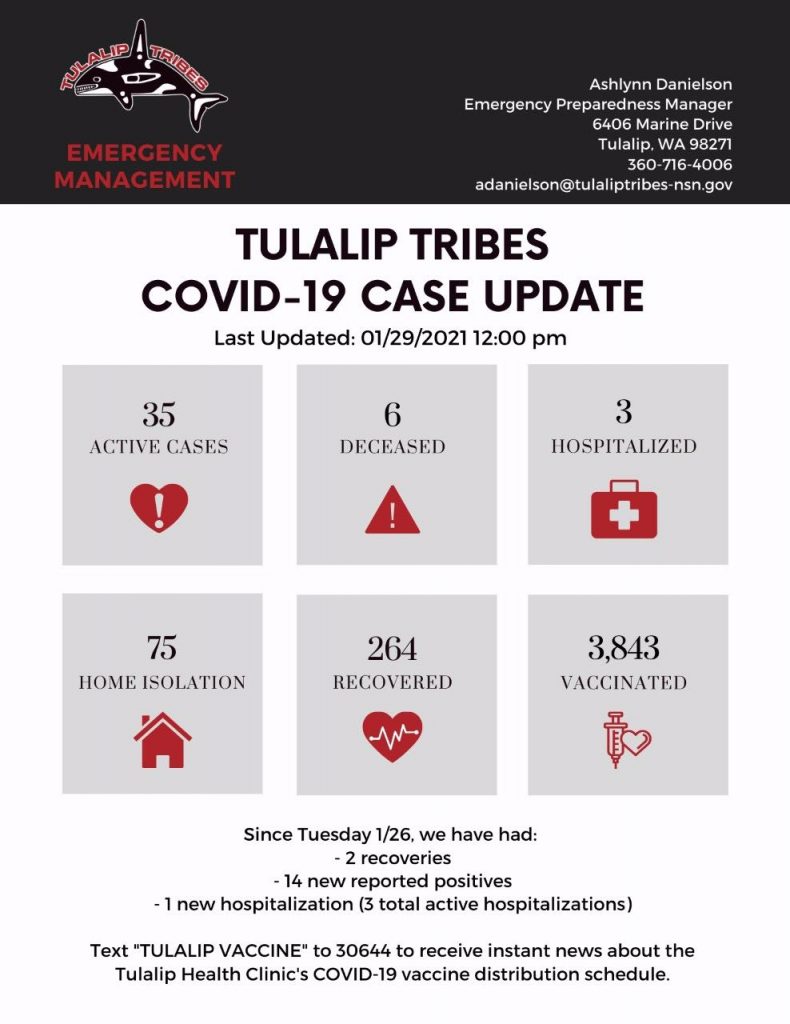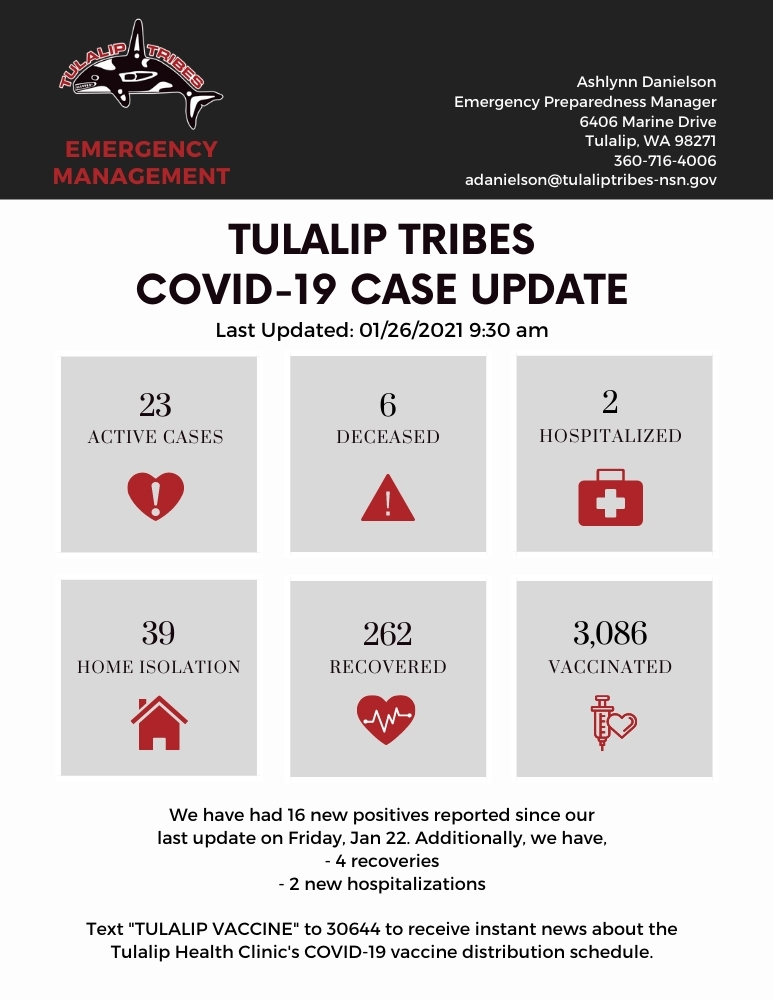
Category: Health
Marysville School District staff made a high priority, given Covid-19 vaccine by Tulalip Tribes
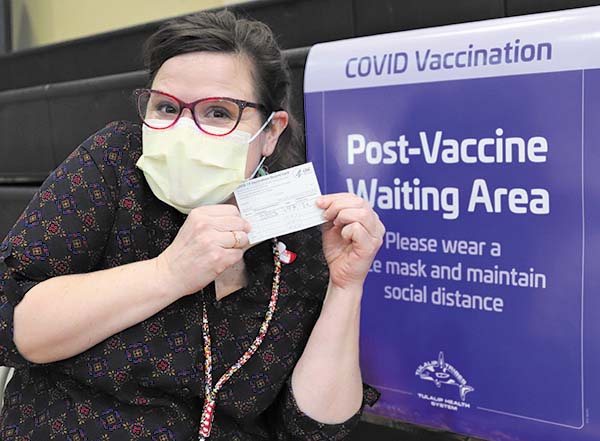
By Micheal Rios, Tulalip Tribes
During the week of January 27, an incredible act of graciousness occurred as the Tulalip Tribes leadership chose to offer every single teacher and support staff of Marysville School District (MSD) an opportunity to circumvent Governor Inslee’s priority list and receive the potentially lifesaving Covid-19 vaccine. Tulalip understands the invaluable role educators play in the lives of our youth and as such exercised tribal sovereignty in deeming all MSD staff a high priority.
“After taking care of our own tribal members, we thought it was appropriate to take care of our teachers because they take care of our kids,” explained Chairwoman Teri Gobin. “We know the value of taking care of the community, especially those entrusted to educate our youth. This is awesome being able to help out local communities and Marysville School District.
“To offer the vaccine to the teachers is phenomenal because it means our students will be able to get back to school and their teachers will remain safe,” she added. “By offering the vaccine to our teachers and other [essential service workers], we’re making our entire Tulalip community safer. It’s a means to get through this time together, so that we can again gather normally, have our traditional ceremonies and celebrate life again, together instead of apart.”
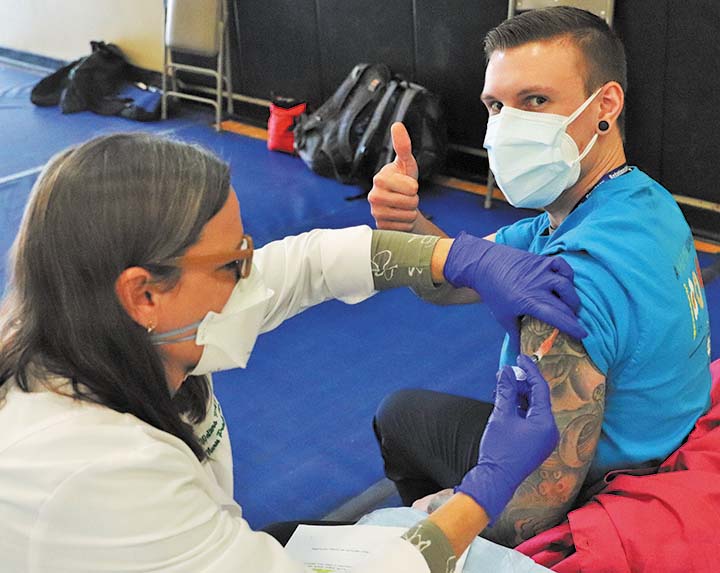
It’s been over a month since Tulalip received the much heralded Moderna vaccine. Over that time resources were directed at getting as many Tulalip tribal member households vaccinated as possible. Then emphasis was put on employees of Tulalip’s essential businesses. Now, the tribe is committed to its local educators as they prepare to reopen select grade levels in the coming weeks and hold in-person learning once again.
When the tribe reached out to MSD and informed them of the vaccination opportunity, the school district surveyed every staff member asking if they wanted the vaccine. Nearly 90% responded with ‘yes’.
From Wednesday, January 27, thru the following Friday, school district personnel travelled into the heart of the reservation to visit the makeshift vaccination distribution center that was the Tulalip Youth Complex. Highly excited and appreciative teachers formed a socially distanced line that wrapped around the building and went down Totem Beach road while waiting to be vaccinated.
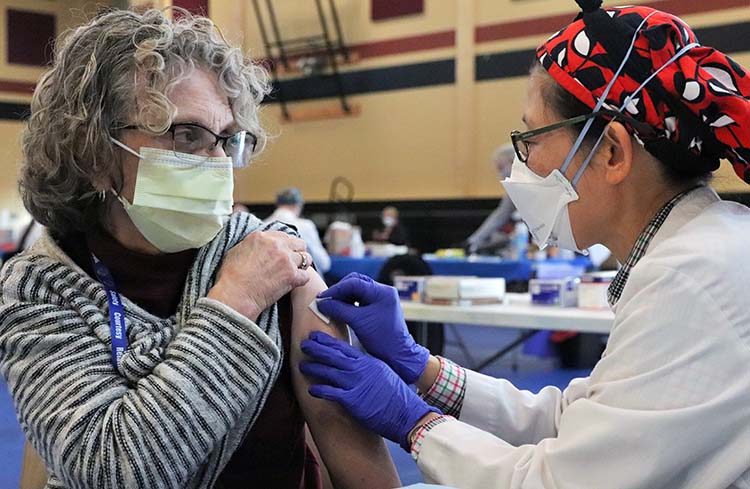
“Today exemplifies the amazing partnership that Marysville School District and the Tulalip Tribes have,” said school district superintendent Jason Thompson shortly after receiving his Covid-19 vaccination. “It’s difficult to not get emotional because I’ve personally witnessed so many teachers come into our offices to fill out their necessary medical forms for today and they were in tears. They couldn’t believe they were getting this opportunity. We’re so fortunate and it’s simply amazing the tribe is doing this.”
A majority of MSD faculty would have been forced to wait weeks, if not months, to be eligible for a vaccination at city, county, and state hospitals under Governor Inslee’s guidelines. Being a sovereign nation, Tulalip does not have to adhere to the Governor’s office and has sole discretion over how and to whom it distributes the vaccine. This critical distinction is viewed as a timely miracle that helps protect loved ones within the community.
“I live at home with my father who is high-risk and having this opportunity to get vaccinated to protect him means so much. This means the world to me,” described 27-year-old Tanner Edenholm, a para-educator for Quil Ceda Elementary. “We’re all a family within the Tulalip community, and I appreciate so much how the tribe is protecting its community and saving lives through its vaccine distribution.”
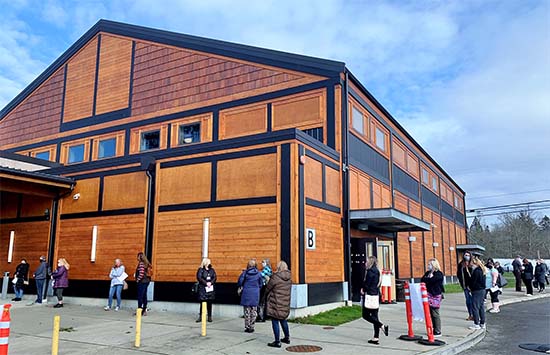
A huge sense of relief and hope for the future was shared by the hundreds of teachers and support staff, from bus drivers to cafeteria workers, who together make it possible to have a safe and instructive learning space for the school district’s young students. Many of whom are eagerly awaiting a return to the class room where they can be reunited with friends and entrusted educators who are viewed as family.
“It’s really important for us to get our students back safely, and part of that is protecting our staff. Getting vaccinated adds that layer of protection so that we can get our students back sooner rather than later,” shared Principal Kelli Miller of Heritage High School. “It’s important for our kids to know that we are doing this for them because we miss them so, so much and can’t wait to see their beautiful faces in real life again. I’m hoping that when we are able to share the same physical spaces again that we all lean in and support each other. Creating that healthy environment where we can all continue learning and growing together is just around the corner, hopefully.”
Covid Case Report, January 29, 2021
Tulalip programs unite for expectant mothers and future generations
By Kalvin Valdillez, Tulalip News
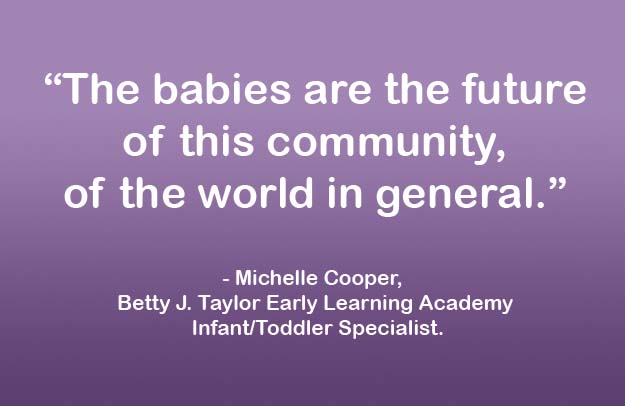
A long-practiced tradition in many Native American cultures has to do cause and effect, decision-making and understanding how an action taken today can have an impact on the quality of life for our people in the future. Through the seven-generation principle, tribes nationwide are making positive changes within their community whether it be educational, economic, cultural, financial, or health-based, keeping in mind our children’s children. And for as far back as many can recall, the ancestors of the Tulalip people have always had their descendants’ best interest in mind, keeping the lifeways of the people alive during a time when cultural identities were being stripped away by forced assimilation.
“The babies are the future of this community, of the world in general,” expressed Michelle Cooper, Betty J. Taylor Early Learning Academy Infant/Toddler Specialist. “I think it’s important to make sure that we’re supporting them as best we can, as well as their parents and their families. We want to make sure everybody feels comfortable and knows we’re a team. Like they say, it takes a village; and I think it’s important to continue that on.”
Keeping true to the seven-generation principal, several departments within the Tulalip Tribes have provided services for the youth of the community for years, starting from birth and extending past high school, ensuring the children are presented with many opportunities to learn about the traditions of their people as well as succeed in their journey from adolescence into adulthood. But what many may not know is there are multiple departments within the Tribe that also help soon-to-be Tulalip tribal members, offering services to expectant mothers before, during and after the birthing process.
For instance, Tulalip Family Haven hosts a weekly hangout specifically for the mothers at Tulalip called Mom’s Group. Pre-COVID times, the group sessions allowed local moms the space to reflect, share ideas, create crafts with their children, take part in a clothing exchange and receive incentives such as car seats and diapers in bulk. Mom’s Group also warmly welcomed first-time pregnant mothers to discuss what to expect as a new mom and express any emotions they may be going through so other moms could in-turn relate and offer words of advice to help her work through any struggle she may be facing. Throughout the past year as we navigated the pandemic, Mom’s Group continued to gather on a weekly basis via the Facebook messenger app.
“We are a support group that allows mothers and women raising kids the opportunity to come together,” said Sasha Smith, Tulalip Family Haven’s Family and Youth Support Coordinator and Mom’s Group moderator. “We wish to provide a sense of belonging, a sense that there’s other women in our community to support each other, a place where we can come and just talk about motherhood and ask questions that are hard to ask your doctor or anybody in your family. They’re able to open up and just have a healthy discussion about childbirth and raising your children.”
She continued, “We are still continuing on with Moms Group, virtually. We’re able to do it over Facebook, we still meet every Tuesday from 11 (AM) to Noon. We just drop-in for about 5-10 minutes, we make sure there’s some kind of lesson. It’s amazing to see that they still have those strong connections with each other and that they still really enjoy showing up every Tuesday and having that time with their friends on Zoom.”
The Betty J. Taylor Early Learning Academy, commonly referred to as TELA, has also stayed in touch with their students and families throughout the pandemic. During normal school years, the academy routinely held workshops for expecting parents that focused on the importance of early childhood development and worked with the parents, helping them get situated and ready for the new baby. TELA recently resumed in-school instruction again, but are not back to full capacity as of yet, and are still offering Zoom lessons to a handful of students.
Said TELA Director, Sheryl Fryberg, “Right now, TELA is doing a lot of Zoom meetings with our children and families. We are only providing direct services to up to 75% of our students, I think we maybe have, more realistically, about 60-65%. And then with the rest of the students, the teachers do Zooms with them and provide activity packets, so they’re still receiving educational services from us. We want to provide all the support that we can, and especially with our young moms and just moms in general, they need support when they’re isolated and not seeing their families. We want to always make sure that they know that we’re here for them.”
Another department that assists pregnant mothers and new families is Tulalip Community Health, through the birth equity grant.
“I am a Community Health nurse, as my primary role, and I have an background in OB,” explained Morgan Peterson, Tulalip Community Health Nurse. “I’ve been a part of the birth equity grant which is focused on improving birth outcomes for pregnant women and the young children that they have. So, in my role, I try to focus on the nursing portion of it, case management of at-risk pregnant women and those young babies that have had NICU stays, being a hospital liaison for them.”
Added Shayleigh Tucker, Tulalip Community Health Advocate, “I really like to call it a doctor translator. We are able to be the in-between, between the community language and the language that providers are using, and explain what they’re doing. We also work with people’s care teams to get them the best suitable care available. We were going to medical appointments with people before COVID. Right now, patient advocacy looks a lot more like helping our community members feel empowered in their prenatal care, it’s a lot more text and call-based.”
Throughout the COVID-19 outbreak, these departments have remained readily available to expectant mothers and have continued offering their services and resources. And now, taking it a step further, they are combining forces to reach even more people within the community who may not know what they have to offer new moms and young families, as well as to better serve their current clientele.
“Our plan for the new group, MCHC, is to establish a monthly parent education discussion group,” said Family Haven Manager, Alison Bowen. “Our plan, for now, is Zoom education for the community. MCHC stands for Maternal Child Health Committee and the purpose of this group is to bring together all the different Tulalip entities that are working with families with young children, up to age five. Since we’re all serving these families in different ways, we thought why don’t we all come together, find out what families we’re serving and not serving, what might be some problem areas where we can improve, what additional outreach we can do, as well as using our funds and our knowledge in the best way, so we’re not duplicating services, but building on each other’s strengths.”
Officially kicking-off in February, MCHC will host a class once-a-month through Zoom, offering information to expectant mothers and their families and also providing any resources or services they might require. Originally a concept that formulated in the library of old Tulalip elementary school, roughly six years ago, between TELA and Family Haven, the idea has now come to fruition and MCHC members are excited about the new collaborative venture.
“I’m excited about the cohesiveness between all of us coming together,” Morgan stated. “And also, for the families to also see that we’re all united, working on the same things to support everybody, their children and their families.”
“I like this collaboration that we have going on,” said TELA Birth to Three Assistant Manager, Marci Vela. “There’s a lot of resources that our pregnant moms might not know they have access to, and they kind of lose out on those services. This is a good way to let them know they have the support of all of us as a community.”
The once-a-month MCHC classes will have a new theme every session and each department will take turns with the hosting duties, in which they will include an educational component as well as some fun activities. The participants will also get the chance to receive incentives, ask questions, address any of their fears or concerns, as well as connect with other mothers and discuss the few challenges and many successes that come with being a new mom.
MCHC has a number of ideas for the upcoming classes including a Father’s Day event, doula training, and lactation and feeding education.
“I am a certified lactation educator and provide lactation and feeding support for infants and young children,” said Tulalip Child Health Educator, Erika Queen. “Pretty much any way of feeding an infant and child, I’m happy to help with.”
With the establishment of the MCHC, Family Haven, TELA, Community Health and beda?chelh are creating a better tomorrow for the future generations of Tulalip, not only by taking care of their soon-to-be membership before birth, but also ensuring that the mothers are in a healthy state -mentally, emotionally, and physically during the early stages of the beautiful journey known as motherhood. More details will begin to arrive in the upcoming weeks as MCHC gears up for their very first Zoom event, happening this February. Stay tuned to Tulalip News for more information and help spread the word to those who could benefit from the services, education and resources provided by the Maternal Child Health Committee.
Sasha expressed, “We’re such a close-knit community, most people know each other and everybody’s intertwined in family. I think it’s important to have an additional outlet. Yes, you can go to your aunties and to your grandmas to get advice, but sometimes it’s refreshing to come together and gain that knowledge and support from your peers. To help them understand that they’re all going through similar things and that they can get through whatever it is they’re going through together.”
Covid Case Report, January 26, 2021
Medicine Wheel mural honors essential employees
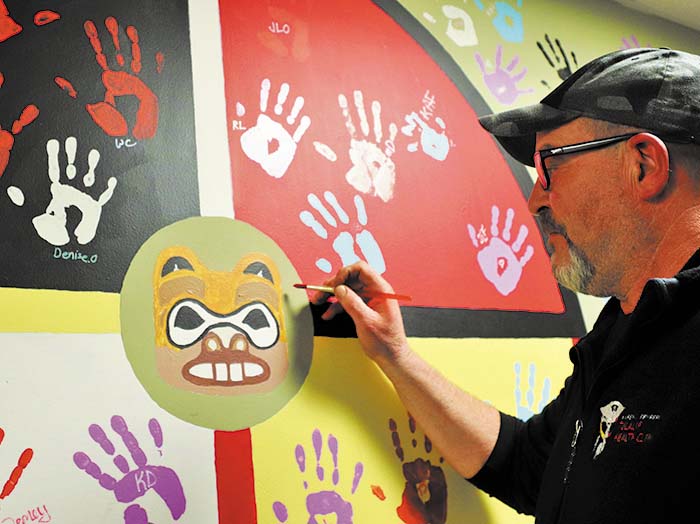
By Micheal Rios, Tulalip News
The Medicine Wheel, sometimes referred to as the Sacred Hoop, has been used by generations of various Native American tribes for health and healing. It embodies the Four Directions – often interpreted as the four aspects of life: spiritual, emotional, intellectual and physical – all of which come together to symbolize the cycle of life. For healers, the Medicine Wheel often represents an omnidirectional perspective on health care. A perspective known as holistic healing, which considers the whole person – mind, body and spirit – in the quest for optimal wellness.
During the midst of a global pandemic, the Tulalip Tribes shut down all non-essential departments for several months, but the quest for wellness continued at the local health clinic where nearly one hundred health care workers and support staff were deemed essential. These employees carried out their daily responsibilities to the Tulalip community while COVID-19 steadily penetrated the reservation. Their commitment to uplifting health opportunities and bringing about wellness to their patients is now immortalized in a remixed Medicine Wheel mural.
“After COVID hit us here locally, I was inspired to cheer people up and boost our sense of team accomplishment here at the clinic. This mural is to honor all our essential staff who worked tirelessly during the tribal-wide shut down,” explained muralist Mark Dewitt, facility maintenance supervisor. “From administration to dental to medical, even some behavioral health specialists, and all my maintenance and custodial crew, together we made sure the Tulalip Health Clinic remained open and available for all its patients.”
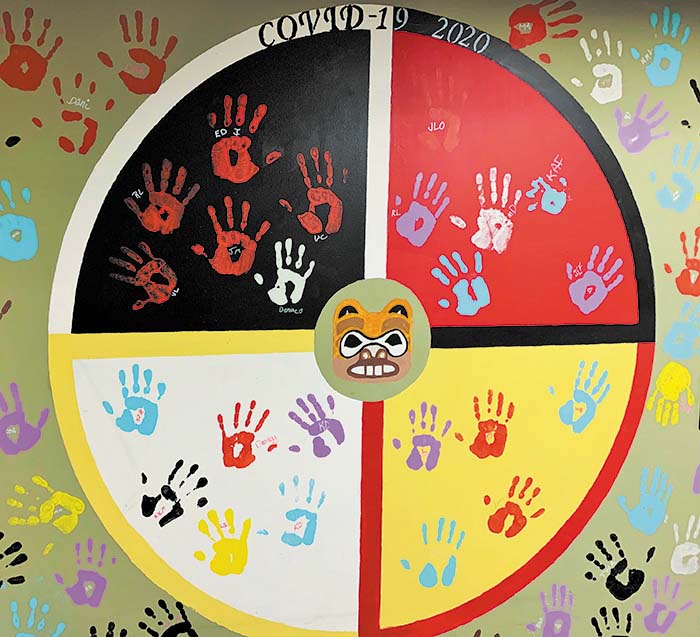
The mural is a can’t miss feature along a back hallway of the health clinic. Eighty-two vibrant handprints represent unique signatures from the clinic’s essential employees. Dewitt said it was a process tracking down each employee and finding time for them to leave their proverbial mark on the mural, but the final product was well worth it.
“Everybody loved it. From the leadership staff down to maintenance, it was a great team building exercise that let everyone know it took each and every one of them to make this place function smoothly,” said Mark. He also noted the wheel’s center hub, a beaver, represents the maintenance team. Beavers build, they maintain, they’re always busy and they’re dam good.
As the number of confirmed cases in Tulalip peaked in late November and steadily decreased since, in addition to an enthusiastic embracing of the Moderna vaccine by Tulalip tribal members and employees, there is a renewed sense of optimism for the future. On the business side, the Tulalip enterprise is back to business as usual, albeit with social distancing and mask-wearing protocols now in place.
One wall in the health clinic will always serve as a striking reminder of the essential hands that worked together to ensure the quest for wellness never came to a halt. Like the Medicine Wheel, the community’s dynamic self was prioritized and continues to be treated holistically.
While adding the finishing touches to his mural, Dewitt reflected back to March 2020 and an unprecedented tribal-wide shut down. “We stuck it out, we were here for the community, and together we fought this battle and survived,” he said. “And these are the hands that did it all.”
Covid Case Report, January 19, 2021
Meet Dr. Kay Moua, advanced diabetes management specialist for Tulalip’s health clinic
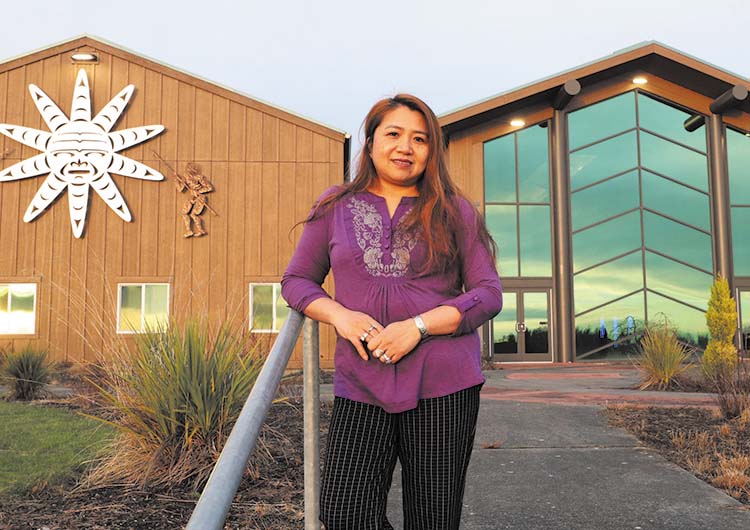
By Micheal Rios, Tulalip News
Native communities and diabetes. The two have been linked since colonization forcibly removed tribes from their ancestral lands and traditional food sources. Ever since it’s been a never ending struggle to battle one of the most challenging health problems of the 21st century. According to the World Health Organization, each year an estimated 1.8 million deaths are directly caused by diabetes, while another 2.2 million deaths are attributed to high blood glucose.
It’s no question that diabetes is a nationwide health problem, but for Native people its life altering effects are felt at a much higher rate. Native communities have the highest diabetes prevalence of all ethnic groups in the United States. Nearly 1 out of 6 Native citizens has diabetes presently, and the Centers for Disease Control predicts that 1 in 2 Native children born since 2000 will have type 2 diabetes in their lifetime.
Fortunately, Tulalip is excited to announce a vital new resource in its fight against the shared enemy. Dr. Kay Moua has joined the health clinic’s Diabetes Care and Prevention Program. An advanced diabetes management specialist, she brings a treasure trove of experience and cutting edge knowledge. She is well regarded for her expertise in the latest techniques and most effective practices for managing and preventing diabetes.
Dr. Kay was gracious enough to be interviewed by syeceb staff in order to introduce herself, her medical background, and what she hopes to accomplish in Tulalip.
SYS: You have a unique cultural background. Can you tell us about it?
I was born in Laos, and my ethnicity is Hmong. My family migrated to a refugee camp in Thailand after the Vietnam War and came to the Unites when I was 11-years-old. I started learning English (e.g. the alphabet, colors, numbers) in 7th grade.
My husband and I have been married for 30 years. We have 4 children, 3 boys and 1 girl. We are family-oriented people and love to host. My husband is the oldest of seven siblings, so we’re always surrounded with family and friends. My in-laws live on the same property, which is common for us to have multigenerational living in the same house. My mother-in-law is a Shaman, so we still perform traditional rituals and practices.
SYS: Please describe your educational journey to become Doctor Kay.
I’ve worked in the medical field since graduating High School. My first job was in a family practice where I started as a receptionist, then later trained in back office work, which included billing and rooming patients. I attended a community college while working full-time. After completing my AA degree in Medical Office, I continued school in the pursuit of a nursing degree.
Once I graduated with my Associate Degree in Nursing and earned my license, I went to work as a Registered Nurse (RN) at Providence hospital in Everett. Seeing so many people come into the hospital with poor diabetes control motivated me to pursue my Nurse Practitioner license to help people living with diabetes. After attending graduate school, where I received my Master’s Degree in Nursing (MSN) and Advanced Registered Nurse Practitioner (ARNP) license, I joined the Endocrinology team at the Everett Clinic to care for patients with diabetes.
Even though I enjoyed my work very much, I knew that I need to get back to school to achieve my personal goal of having a doctoral degree. With hard work and dedication, I graduated with a Doctor of Nursing Practice (DNP) degree in 2015. I continued to take extra classes and trainings and was able to pass the National Board Certified-Advanced Diabetes Management (BC-ADM) certification the following year.
SYS: What motivated you to join the Tulalip Health Clinic and practice medicine for the Tulalip people?
Native Americans are one of the highest risk groups for the development of diabetes. I was surprised to find out that in the history of the Tulalip Health Clinic an Endocrinologist or someone like myself has not been available for the people of Tulalip without a referral to an outside facility. I am pleased to be one of the first contracted providers to manage patients utilizing devices like CGM and insulin pumps. These technologies have evolved over time and under my care and direction we will be offering these devices in 2021 to patients who have this interest in advanced diabetes management.
The Tulalip Health Clinic already has a successful Diabetes Care and Prevention Program. I love the fact that the program is able to provide so many activities to teach people about diabetes and keep the community engaged with the clinic. In fact, I’ve never came across another diabetes program that is so unique and able to provide so much for their patients. I want to work with the team to help expanding the diabetes program by offering advanced diabetes care to Tribal members, to ensure that their treatment is up-to-date with most current medications and have the option to use technologies to enhance diabetes management. Tribal members should not have to seek care outside the Reservation for diabetes treatments.
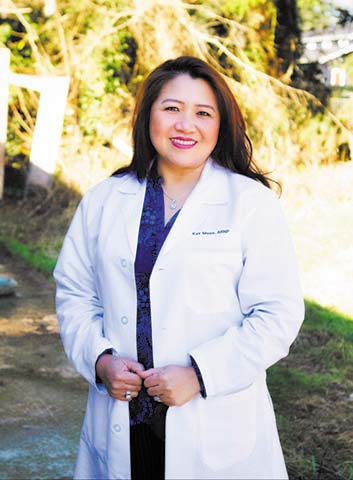
SYS: You specialize in advanced diabetes management. Can you explain what this means?
As I mentioned earlier, diabetes care has been my main focus from training during Nurse Practitioner school and my doctoral degree school. I’ve worked with patients with diabetes for over ten years. I continue to immerse myself with conferences and continuation education that’s specialized on diabetes to stay up-to-date with current medications and technologies and guidelines.
I’m an Advanced Registered Nurse Practitioner (ARNP) by trait, with a Doctor of Nursing Practice (DNP) degree and national Board Certified-Advanced Diabetes Management (BC-ADM) specialist. Patients are referred if they need to improve blood sugar control or have interest in insulin pump or continuous glucose monitor. Diabetes treatment is complicated and has to be individualized. I make sure that patients are offered the best and most appropriate treatment options available to the individual.
I also have extensive experience incorporating technologies such as continuous glucose monitors and insulin pumps to help patient improve diabetes control. Insurance requires additional documentations and special forms for approval. These technologies requires extra training and longer appointment time with patients that may not be feasible for general providers. This is why my service is required. I work with these devices every day and familiar with insurance requirements for quick approval.
SYS: With your extensive professional experience, what do you consider the biggest challenges to minimizing the diabetes epidemic?
Unfortunately, diabetes prevalence continues to increase every year. There are many contributing factors to this epidemic. I think our current financial economy posts many obstacles in diabetes prevention and treatment. Budget is tight in most households, especially with more and more people losing their job during COVID, leading to even more unhealthy diet and lack of exercise.
We all know the importance of a healthy diet. However, it may not always be feasible when you have a tight budget. Fresh food costs 2-3 times more than process food. People are working longer hours and don’t have time to cook, so they are eating more fast food. Combining processed and high fat foods with eating late at night contribute to weight gain, leading to increased insulin resistance or worsening diabetes control.
Healthy diet and routine exercise are the cornerstone of diabetes prevention and treatment. As people are working longer hours to make ends meet, they don’t have time to do anything else. Exercise is unlikely to be a high priority after a long work day. Lack of exercise increases fatty tissue, which causes insulin resistance and high blood sugar.
SYS: In your ideal scenario, how will your work positively impact the Tulalip community?
Diabetes management is complex and requires collaboration between the patient, their family members and the healthcare team to achieve best outcomes. As a new provider of the community, it’s important for me to learn the culture and incorporate the Tribal ways of living when making treatment plans. I believe getting to know the people, developing good rapport with patients, and building trust with the community are the key steps to improving diabetes control within the Tulalip community.
My understanding is that some tribal members have been going elsewhere for advanced diabetes care or have not been active in seeking diabetes care. My goal is to provide the most current diabetes treatment options for members living with diabetes right on the reservation. I will need to prove my knowledge and earn the trust of the community in order to draw members back to the Tulalip Health Clinic for diabetes management.
SYS: A principle of Native culture has always been holistic care (mind, body and spirit). Considering this, what advice or best practices would you suggest to combat diabetes and pre-diabetes?
I’ve always believe in holistic care approach. It is crucial to access and address the individual’s mental and physical health that may impact their ability to maintain diabetes management. Successful diabetes care also requires taking the time to access and get to know the patient, their family, their environment, and cultural practices and incorporating this information into individual treatment plans. We all have different cultural practices and traditional food that should be respected.
I’m so excited that the Diabetes Care and Prevention team has a garden to showcase and incorporate the Pacific Northwest native plants for natural medicines and herbal remedies. The Diabetes Program garden provides diabetes education and promotes traditional food, healthy eating, and activity. Healthy diet and staying active are important for everyone, but even more crucial for those who have diabetes or prediabetes.
My goal is to be a resource and provide guidance for patients who have diabetes or at risk of developing diabetes through obstacles like diet, exercise, blood sugar checking, or medication management. Uncontrolled diabetes can cause many unforgiving long-term complications. Diabetes can start to cause damage to internal organs in prediabetes state. Therefore, it is important to do everything you can to maintain good blood sugar control if you are considered high risk or as soon as you found out that you have diabetes.
My vision for the Tulalip Diabetes Program is to expand diabetes care to Tribal members with prediabetes. Historical records show that at least 20% of these patients convert to full blown type 2 diabetes yearly. We need to focus our attention on preventing diabetes in order to decrease the diabetes epidemic. I hope that we will be able to offer routine educational group classes on diabetes disease and have activities to promote healthy eating and active living once it’s safe to have group classes again. In the meantime, I encourage everyone to find safe activities to stay active and practice meal portion control.
SYS: Anything else you’d like to share to our readers?
Special thanks to Roni Leahy (Tulalip Diabetes Program Coordinator) for having the vision to expand the Diabetes Care and Prevention Program and entrusting me with this opportunity. I am grateful for the support from Dale Jones (Diabetes Program Advocate) and Brooke Morrison (Diabetes Program Assistant). I also like to thank the Tulalip Healthcare providers, Dr. Chad Cleven, Dr. Natasha LeVee, Dr. Howard Johnson, Dr. Rhonda Nelson, and Dr. John Okemah for welcoming me to the clinical team.
It is an honor and privilege to have the opportunity working with the Tulalip Health System. I look forward to learning the Tulalip culture, earning the trust of each patients and the community, and collaborating care with the clinical team to improve the health and quality of life of tribal members suffering from diabetes.
A remarkable achievement! Moderna Vaccine welcomed with open arms in Tulalip

By Micheal Rios, Tulalip News
On January 19, 2020, a 35-year-old man presented to an urgent care clinic in Snohomish County with a four-day history of cough and subjective fever. He disclosed he returned to Washington only days prior after traveling to visit family in Wuhan, China. After multiple days of examination and a litany of tests, it was revealed that the man was positive with a severe acute respiratory syndrome caused by a novel coronavirus. This was the first confirmed case of COVID-19 in the United States.
Nearly one year later, the COVID pandemic continues to rage on. According to the Department of Health, there have been 246,000 confirmed cases and 3,482 deaths in Washington State attributed to the virus at the time this article was published. A whopping 91% of those deaths are individuals at least 60-years-old.
On the Tulalip Reservation, those who are 60+ are revered as elders. They are a living history, a source for cultural and spiritual knowledge whose wisdom is irreplaceable. Protecting them from COVID is of utmost importance, which is why the Tulalip Health Clinic was full of hope and excitement on December 23 as the first doses of the much heralded Moderna Vaccine were administered to Tulalip’s most vulnerable.
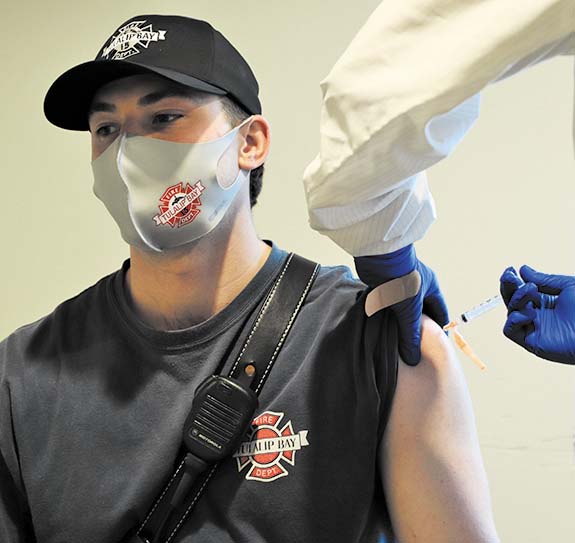
“Today is a great day for Tulalip! We have received the COVID-19 vaccine,” marveled Tulalip tribal member and Patient Care Director, Jennie Fryberg. “My hands go up to everyone who comes to our health clinic to get vaccinated and help save lives, save our community, and save our elders. The 2020 year was a tough one for us because we lost some loved ones to the pandemic. I’m getting vaccinated for my parents, so I can protect them and avoid possibly spreading COVID to them. My advice to our community is come and get vaccinated so we can have a much more hopeful 2021.”
After months of battling the pandemic at the reservation’s go-to health care facility, Tulalip’s emergency management team’s latest update states four Tulalip elders have died with COVID-19. Two were in their 70s and two were in their 80s. Their memories live on in the younger generations who carry on their cultural traditions with pride.
In order to protect as many remaining elders and high-risk tribal members, Tulalip’s medical personnel promptly rolled out phase one of COVID vaccinations after receiving 400 initial doses from Moderna. The immediate recipients were Tulalip’s elders, most high-risk citizens, first responders, and frontline healthcare workers.

“This is an amazing event taking place and I feel so fortunate to play a role in offering protection and hope to such a beautiful community,” said medical assistant Kristina Bartek while filling syringes with the potential lifesaving Moderna Vaccine. “My grandfather is 84-years-old and it scares me to think of what could happen if he gets COVID. I’ll be getting vaccinated to protect him, myself, and anyone I come into contact with.”
History was made as the first administered vaccination went to Tulalip elder Dale Jones. “We are fighting a very dangerous virus and have already lost some of our people because of it,” shared Dale moments after getting vaccinated. “This vaccine means we finally have protection for our people, especially our elders.”
Real life heroes who put their lives on the line every day to keep the community safe were eager to get a literal shot in the arm to ensure they can carry out their duties while preventing COVID exposure to others.
“This is a big moment for our community and our fire department by ensuring the health and safety of our first responders,” said Fire Chief Ryan Shaughnessy while joining his team in getting vaccinated. “We’re really excited and grateful for the Tulalip Tribes generosity to vaccinate our team. Moving forward, we can fulfill our duties with more confidence knowing we’re vaccinated against this deadly virus.”

It’s been two weeks since Tulalip received the vaccine and the health clinic has administered 407 vaccinations as of January 4. Phase two of vaccinations is now underway. Tulalip tribal members ages 50+ and who have chronic health conditions may now stop by the clinic for a vaccination visit.
If you are a Tulalip elder and not yet received the vaccine, please visit the clinic as soon as possible to do so. You do not need to make an appointment nor call.
“The Moderna Vaccine is a remarkable tool that helps us to decrease the spread of COVID and mitigate life threatening concerns associated with COVID,” said Dr. John Okemah, Chief Medical Officer. “Finally having a vaccine available to our people brings about a new sense of hope to our people throughout Indian Country. We’ve been dealing with this global pandemic for close to a year now. By getting vaccinated we, as a community, are now fighting back and doing what we can to protect our loved ones.”
Tulalip Community Health Youth Care Kits
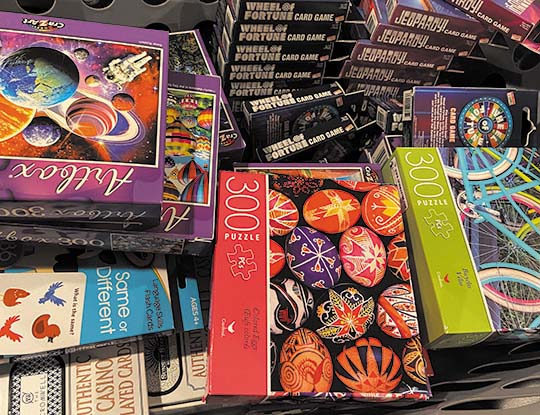
Submitted by Morgan Peterson, Tulalip Community Health Nurse
Mental health is just as important as physical health. During these difficult times of a pandemic, it’s more important than ever to include self-care in our daily lives. At Tulalip Community Health, we want to provide support to youth that are home on quarantine. We hope these items can help pass the time while at home. We all must do our part to stop the spread of COVID and stay home if exposed to COVID-19 or have tested positive for COVID-19.
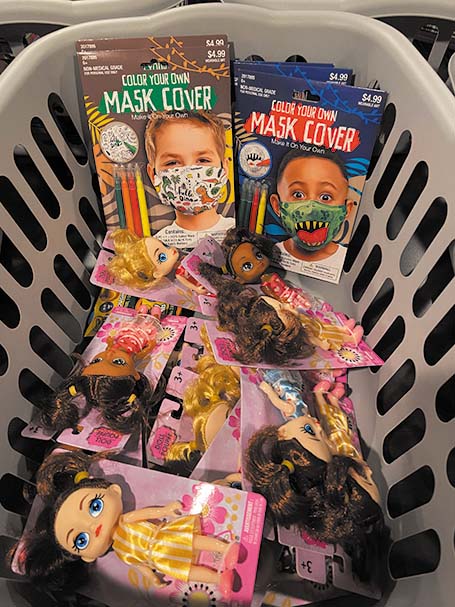
Q. What is a Youth Care Kit?
A. A youth care kit is put together with the specific interests of youth in mind. They have various items from Legos and dolls to cooking kits, art activities, and journals.
Q. Who is eligible to receive a youth kit?
A. Youth kits are available to households in isolation/quarantine due to having a family member in the home testing positive for COVID-19.
Q. What ages do these kits include?
A. The items are for children 3-18
Q. How can I receive one of these Youth Care Kits?
A. There are a couple of ways to receive a care kit:
- When someone is notified of a positive COVID-19 test result, please let the caller know there are children in the home and the ages.
- Call Community Health (360) 716-5662 and request a youth care kit. Please leave a message with your name and good number, and someone will call you back.
- Call Tiffany Robinson from the Community Health Transportation Department (360) 722-1635
